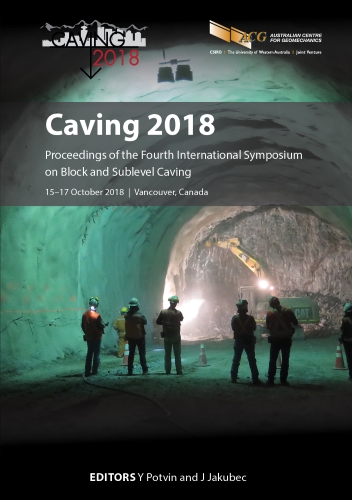Experiments and simulation of gravity flow in block caving through FlowSim

|
Authors: Castro, R; Arancibia, L; Guzman, D; Henriquez, JP |
DOI https://doi.org/10.36487/ACG_rep/1815_21_Castro
Cite As:
Castro, R, Arancibia, L, Guzman, D & Henriquez, JP 2018, 'Experiments and simulation of gravity flow in block caving through FlowSim', in Y Potvin & J Jakubec (eds), Caving 2018: Proceedings of the Fourth International Symposium on Block and Sublevel Caving, Australian Centre for Geomechanics, Perth, pp. 313-322, https://doi.org/10.36487/ACG_rep/1815_21_Castro
Abstract:
In block caving, gravity flow plays a key role as it influences ore recovery and dilution. Recent research at the University of Chile has been directed towards expanding the understanding of gravity flow through experiments that could be included in gravity flow simulation tools. FlowSim BC is a rapid simulation tool for gravity flow for long-term block caving planning purposes, which is based on the cellular automata approach. This approach has flexibility to incorporate observed flow mechanisms through unique local rules, which are applied to a discrete media that emulates the caved rock. The mechanisms used in developing FlowSim have been obtained through controlled experiments and mine data analysis. In this paper, the authors present a summary of new understandings obtained through experiments and field data, and the methodology used to calibrate the new mechanisms included in FlowSim. The results indicate that the complexities of gravity flow in block caving applications can be modelled, and that this type of modelling tool can be used effectively for mine planning purposes.
Keywords: block caving, gravity flow, mine planning
References:
Altamirano, A & Castro, R 2018, Draw Analysis for PC1-S1 and PC2, internal report to Newcrest Cadia Valley Operations, BCTEC Engineering and Technology, Santiago.
Arancibia, L 2018, Experimental and Empirical Modelling of Dilution for Block Caving, Master’s thesis, University of Chile, Santiago, under preparation.
Brown, ET 2003, Block Caving Geomechanics, Julius Kruttschnitt Research Centre, Indooroopilly, and The University of Queensland, Brisbane.
Castro, R 2006, Study of the Mechanisms of Gravity Flow for Block Caving, PhD thesis, The University of Queensland, Brisbane.
Castro, R, González, F & Arancibia, E 2009, ‘Development of a gravity flow numerical model for the evaluation of drawpoint spacing for block/panel caving’, Journal of the South African Institute of Mining and Metallurgy, vol. 109, no. 7, pp. 393–400.
Castro, R, Hekmat, A, Fuentes, M, Armijo, F & Rodriguez, F 2016, ‘FlowSim – A versatile flow simulation tool to quantify extraction and design alternatives for block caving’, Proceedings of MassMin 2016, The Australasian Institute of Mining and Metallurgy, Melbourne, pp. 645–652.
Cundall, PA, Mukundakrishnan, B & Lorig, L 2000, REBOP (Rapid Emulator based on PFC3D) Formulation and User’s Guide, Julius Kruttschnitt Mineral Research Centre, Indooroopilly, and Itasca Consulting Group Inc., Brisbane.
Fuentes, M 2015, Development and Calibration of FlowSim Based on Smart Markers, undergraduate thesis, University of Chile, Santiago, in Spanish.
González, R 2016, Development of FlowSim 3.0: Gravitational Flow Emulator for Block/Panel Caving Underground Mining, undergraduate thesis, University of Chile, Santiago, pp. 5–27, in Spanish.
Guzman, D 2018, Caving Modelling and Analysis Using FlowSim 5.0, undergraduate thesis, University of Chile, Santiago.
Kvapil, R 2008, Gravity Flow in Sublevel and Panel Caving – A Common Sense Approach, Luleå University of Technology, Luleå.
Olivares, D 2014, Influence of Fines and Humidity on Confined Granular Flow, undergraduate thesis, University of Chile, Santiago, in Spanish.
Sánchez, Y 2017, Gravity Flow Characterization of Fine Granular Material for Block Caving, Master’s thesis, University of Chile, Santiago, in Spanish.
Valencia Vera, ME 2014, Development and Application of FlowSim for Block/Panel Caving Mines, undergraduate thesis, University of Chile, Santiago, in Spanish.
© Copyright 2026, Australian Centre for Geomechanics (ACG), The University of Western Australia. All rights reserved.
View copyright/legal information
Please direct any queries or error reports to repository-acg@uwa.edu.au
View copyright/legal information
Please direct any queries or error reports to repository-acg@uwa.edu.au
